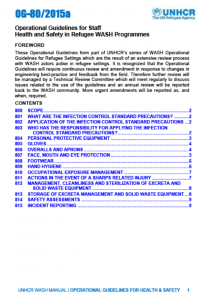 |
OG-802 Operational Guidelines for Staff Health and Safety in Refugee WASH Programmes (UNHCR, 2015)This document provides health and safety guidelines for refugee WASH programmes for staff are involved in either: cleaning of toilets; maintenance of toilets; desludging of toilets; the collection and movement of excreta; the collection or movement of solid wastes; the handling of vector control or water treatment chemicals; any staff who may potentially come into contact with excreta, sewage, wastewater, solid waste, medical waste or any other sources of (potential) infection.
|
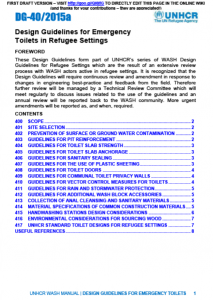 |
DG-400 Design Guidelines for Toilets in Refugee Settings (UNHCR, 2015)This document contains guidelines for toilets in refugee settings including: site selection; prevention of surface or ground water contamination; pit reinforcement; toilet slab strength; toilet slab anchorage; sanitary sealing; use of plastic sheeting; toilet doors; privacy walls; vector control measures; rain and stormwater protection; wash block accessories; collection of anal cleansing and sanitary materials; material specifications; handwashing stations design considerations; and environmental considerations for sourcing wood .
|
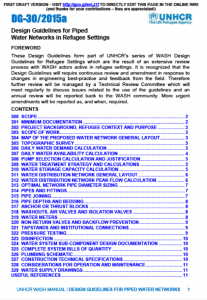 |
DG-300 Design Guidelines for Piped Water Networks in Refugee Settings (UNHCR, 2015)This document contains guidelines to help UNHCR and WASH actors design piped water networks in refugee settings. It describes the minimum documentation that should be included for a water network design project.
|
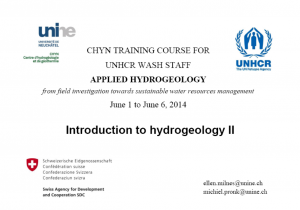 |
Introduction to Hydrogeology (Université de Neuchâtel, SDC and UNHCR, 2015)This 289 page document provides and extensive introduction to applied hydrology and includes the following chapters: Introduction to the training course; Introduction to hydrogeology I; Introduction to hydrogeology II; Basic concepts of groundwater exploration; Bacteriological analysis of water; Basic concepts of groundwater protection; Basic concepts of aquifer characterisation: pumping tests; Well construction and rehabilitation
|
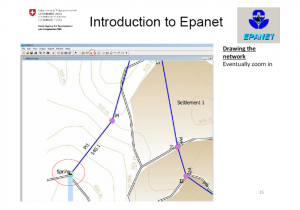 |
EPANET Training Course (SDC, 2015)This 161 page document provides a thorough introduction to EPANET (US Environmental Protection Agency) water distribution network modelling software with a focus on designing networks for refugee settings.
|
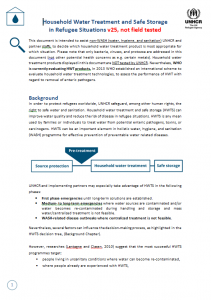 |
Household Water Treatment and Safe Storage in Refugee Situations, (UNHCR, 2015)This document contains guidelines to help WASH actors in refugee settings select household water treatment products. The document includes an overview of: • Categories of HWTS; • Health benefits; • When to use HWTS and existing decision tree; • Criteria regarding HWT to be considered by the field; • Mandatory components; • UNHCR Checklist for HWTS; • HWT concerns; • Household water treatment cards; • Safe water storage;• Further reading; • Acknowledgement
|
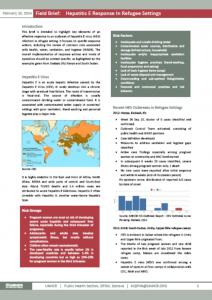 |
Hepatitis E Response in Refugee Settings (UNHCR, 2015)This brief is intended to highlight key elements of an effective response to an outbreak of hepatitis E virus (HEV) infection in refugee setting. It focuses on specific response actions, including the review of common risks associated with health, water, sanitation, and hygiene (WASH). The overall implementation of response actions and mode of operation should be context specific, as highlighted by the examples given from Dadaab (Ifo) Kenya and South Sudan.
|
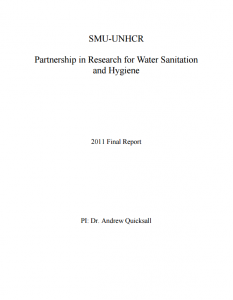 |
Water Quality Study in Refugee Operations (UNHCR and SMU, 2011)The SMU team conducted five sampling missions to UNHCR refugee camps in Uganda, Kenya, Bangladesh, Djibouti, and Liberia. Overall, these missions were considered a success with 17 camps, 7 villages, and a few additional sites visited. The team collected 213 camp samples and 229 total samples for analyses in the laboratory. Camp conditions and source water characteristics varied widely amongst the five countries but also within the camps themselves.
|
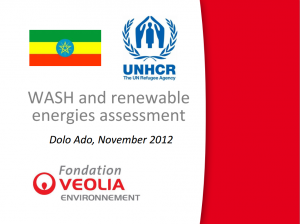 |
Drinking Water, Sanitation and Renewable Energies Assessment – Dolo Ado Camp (Veolia Foundation and UNHCR, 2012)This document looks at drinking water, sanitation and renewable energy solutions and options in three camps in Dolo Odo with recommendations and conclusions.
|
 English
English
